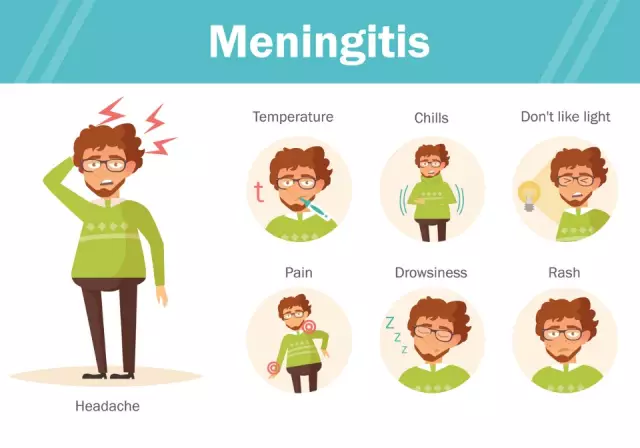- Author Curtis Blomfield [email protected].
- Public 2023-12-16 20:44.
- Last modified 2025-01-23 17:01.
Meningitis is a disease in which, due to the entry of certain microbes into the body, the lining of the brain becomes inflamed. Microbes can be represented by viruses, bacteria, fungi or some other microorganisms. The only condition is that they can penetrate the protection of several layers of cells with which the body has surrounded the brain.
Meningitis most often affects children, as their immunity has not yet developed protection against many microorganisms, because he is simply not familiar with them. And in order to “get acquainted”, you need to have had any form of infection (not necessarily meningitis) or be vaccinated. Therefore, each parent should have information about how meningitis in children manifests itself.
Who is most susceptible to the disease?
It takes several conditions to get meningitis:
- Sufficiently aggressive microbe that can penetrate the brain. By the way, measles, rubella and mumps viruses can become such microbes, and the chickenpox virussmallpox and herpes use the nervous system as a favorite target.
- Weakened body. For children, it’s enough that they are small, their immunity is simply not strong enough, but if they also had something the day before, they got cold, or they had to be given hormonal drugs (for example, to treat eczema, severe allergies or rheumatic diseases), then the chances that a common cold or diarrhea of enteroviral origin can be complicated by meningitis are increasing.
- Prematurity.
- Congenital diseases of the central nervous system caused by intrauterine infection or intoxication (poisoning).
- Tranio-cerebral injury.

How does meningitis manifest in children?
If a child can talk, he indicates that he has a headache. At the same time, he can point with his finger both at the forehead and at the temples, and indicate an indefinite localization, showing that the whole head hurts. This pain is easier to bear when lying down and is aggravated by bright lights and loud noises.
In addition, the child has an increased body temperature (usually - to high numbers), he becomes lethargic, drowsy. That, meningitis in children, as it manifests itself, may resemble a severe course of SARS (especially influenza). Therefore, it is very important for a combination of such symptoms as a headache against a background of high temperature, which disappears for a short time when taking an anesthetic, accompanied by weakness, drowsiness, to call a doctor. And if this is supplemented by the signs indicated below, thenit is best not to wait for complications, but to call an ambulance.
Other symptoms suggestive of meningitis:
- nausea, vomiting, which cannot be associated with the intake of low-quality products; they appear suddenly, vomiting is a “fountain”, after it it does not get better, such vomiting is not accompanied by diarrhea;
- very unpleasant to look at bright light;
- normal touch causes discomfort;
- convulsions in children over 6 years of age against the background of any increase in temperature, up to 6 years - if they appear.
How is meningitis in children manifested? Rash. There is not always a clear relationship between these two phenomena. But if the rash is dark and does not disappear when pressed against it with a transparent glass (it can be a glass), there is a high probability that this is a meningococcal (less often pneumococcal or caused by Haemophilus influenzae) infection, which is life-threatening even without meningitis. Also, meningitis can be complicated by those diseases that are manifested by a rash: rubella, measles, chicken pox, scarlet fever. So any rash in a child is a reason to call a doctor.
How long does it take for meningitis to show up?

It depends on what microbe it is caused by and how the body resists the infection. On average, it takes from two to seven days from the moment of infection to the first manifestations of the disease in viral and primary bacterial (meningococcal, hemophilic) meningitis. Secondary meningitis, which would be a complication of otitis, sinusitis or other bacterial diseases,develops from a week to two.
Meningitis in children: how it manifests before the age of one year
It is one thing if a child can tell what is bothering him, and quite another if he is still too young.
Parents should be alert for the following signs:
- high body temperature;
- prolonged monotonous crying, while the child screams more if you try to pick him up;
- large fontanel becomes tense, protrudes above the level of the skull bones;
- the child takes a forced position in bed: lying on his side, with his head thrown back;
- baby refuses breast or formula milk;
- vomiting "for no reason" (that is, the child could not be fed something);
- convulsions;
- there may be a rash, and more often it is the one that does not disappear when the glass is pressed on it or the skin is stretched under it, since viral meningitis rarely occurs at this age; more often the disease is caused by mennigococcus, pneumococcus, H.influenza, less often by streptococcus or staphylococcus.






